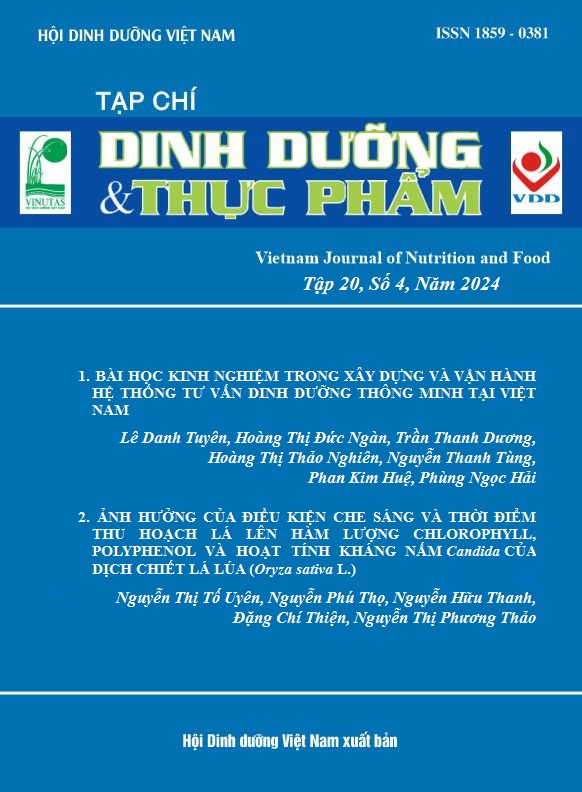ỨNG DỤNG mHEALTH TRONG THEO DÕI, QUẢN LÝ DINH DƯỠNG VÀ SỨC KHỎE: GIẢI PHÁP VÀ THÁCH THỨC
Nội dung chính của bài viết
Tóm tắt
Trong thời đại công nghệ số, việc sử dụng phần mềm và các ứng dụng công nghệ thông tin (CNTT) trong lĩnh vực chăm sóc sức khỏe và dinh dưỡng trên các thiết bị di động - mHealth, đã trở nên ngày càng phổ biến và đa dạng. Bài tổng quan này được tiến hành để phân tích lợi ích và hạn chế của các ứng dụng mHealth, đồng thời đề xuất các phương pháp cải tiến để nâng cao hiệu quả sử dụng. Phương pháp tổng quan hệ thống được áp dụng, với dữ liệu thu thập từ các cơ sở dữ liệu khoa học uy tín thông qua các cơ sở dữ liệu như PubMed, ScienceDirect, Web of Science, và Google Scholar. Các nghiên cứu liên quan trực tiếp đến ứng dụng mHealth trong can thiệp dinh dưỡng, được công bố trong vòng 10 năm trở lại đây, thực hiện trên phụ nữ có thai, trẻ em và cán bộ y tế được đưa vào tổng quan. Kết quả cho thấy, các ứng dụng mHealth có tiềm năng trong việc cải thiện tình trạng dinh dưỡng và sức khỏe, không chỉ giúp nâng cao kiến thức mà còn thúc đẩy thay đổi hành vi và cải thiện chất lượng dịch vụ y tế. Tuy nhiên, việc triển khai và áp dụng các ứng dụng mHealth còn gặp một số thách thức như các vấn đề về bảo mật, hạ tầng kỹ thuật, và khác biệt văn hóa xã hội. Nếu các vấn đề này không được lưu ý trong quá trình thiết kế các ứng dụng mHealth sẽ ảnh hưởng tới hiệu quả và tính bền vững của các can thiệp.
Từ khóa
mHealth, suy dinh dưỡng, trẻ em, phụ nữ có thai, trí tuệ nhân tạo
Chi tiết bài viết
Tài liệu tham khảo
2. Choe EK, Klasnja P, Pratt W. mHealth and Applications. In: Shortliffe EH, Cimino JJ, eds. Biomedical Informatics. Springer; 2021.
3. Haddaway NR, Page MJ, Pritchard CC, McGuinness LA. PRISMA2020: An R Package and Shiny App for Producing PRISMA 2020-Compliant Flow Diagrams, with Interactivity for Optimised Digital Transparency and Open Synthesis. Campbell Systematic Reviews. 2022;18. doi:10.1002/cl2.1230
4. Tine F, Emily K, Natalie R, Colleen E, Melani O’L, Laura S. Developing a Mobile Health App to Manage Acute Malnutrition: A Five-Country Experience. ENN Online. 2017.
5. Ranjan Kumar, Monica Aggarwal, Priya Chaudhary, Bhavya Goyal. A Real Time Automated Measurement of Malnutrition. DU Journal of Undergraduate Research and Innovation. 2018;4(1):83-92.
6. Nimmagadda S, Gopalakrishnan L, Avula R, et al. Effects of an mHealth intervention for community health workers on maternal and child nutrition and health service delivery in India: protocol for a quasi-experimental mixed-methods evaluation. BMJ Open. 2019;9(3):e025774. doi:10.1136/bmjopen-2018-025774.
7. Murthy N, Chandrasekharan S, Prakash M. et al. The Impact of an mHealth Voice Message Service (mMitra) on Infant Care Knowledge, and Practices Among Low-Income Women in India: Findings from a Pseudo-Randomized Controlled Trial. Matern Child Health J. 2019; 23(12):1658-1669.
8. Ward VC, Raheel H, Weng Y, et al. Impact of mHealth interventions for reproductive, maternal, newborn and child health and nutrition at scale: BBC Media Action and the Ananya program in Bihar, India. J Glob Health. 2020;10(2):021005.
9. Khan SS, Patel A, Puranik A, et al. Use of Mobile Health in Infant and Young Child Nutrition: A Formative Study in Rural Maharashtra. The Qualitative Report. 2020. 25(6), 1671-1671. Doi:10.46743/2160-3715/2020.4174.
10.Doan TTD, Binns C, Pham NM, et al. Improving Breastfeeding by Empowering Mothers in Vietnam: A Randomised Controlled Trial of a Mobile App. Int J Environ Res Public Health. 2020;15:5552.
11.Nemerimana M, Karambizi A. C, Umutoniwase S, et al. Evaluation of an mHealth Tool to Improve Nutritional Assessment Among Infants Under 6 Months in Paediatric Development Clinics in Rural Rwanda: Quasi-Experimental Study. Matern Child Nutr. 2021; 17(4):e13201. doi:10.1111/mcn.13201.
12. Mallipu A. Improving childhood nutrition in Indonesia through an innovative behavioural change programme. EBioMedicine. 2021;66:103292.
13.Wu Q, Huang Y, Liao Z, et al. Effectiveness of WeChat for Improving Exclusive Breastfeeding in Huzhu County China: Randomized Controlled Trial. J Med Internet. 2022;22(12).
14.Yu L, Huaiyan J, Yumei Q, Jinsheng Y, Gabriele C. m-Health of Nutrition: Improving Nutrition Services with Smartphone and Machine Learning. Mobile Information Systems. 2023:1-14.
15.Obonyon KO, Kaindi DWM, Ngala S, Kogi-Makau W. Mobile Phone Application in the Management of Maternal and Young Child Malnutrition: A Review. East Afr Med J. 2023;100(10): 6346-6352.


